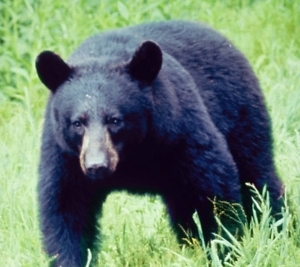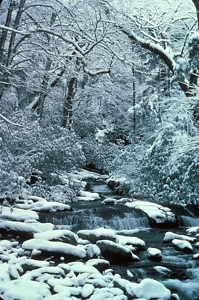With Bears in Winter
The mountains in winter were a revelation as we climbed
FROM THE CHAPTER 16 ARCHIVE: This essay originally appeared on February 1, 2019.
***
Back in the 1980s, while I was a member of the Great Smoky Mountains Conservation Association, my wife Anne and I were allowed to take part in a black-bear research study in the Great Smoky Mountains National Park. The project was led by Dr. Michael Pelton, a zoology professor at the University of Tennessee. We had met Mike on an earlier project, re-introducing river otters into Abrams Creek, so he was comfortable with having us come along on the bear project.
 Mike would begin his work during the warm months of summer and fall, when he and his staff would trap female black bears and fit them with radio-tracking collars. Then, in late winter while the bear was still hibernating, they would track her to her den for examination. The project had been going on for several years before Anne and I became involved.
Mike would begin his work during the warm months of summer and fall, when he and his staff would trap female black bears and fit them with radio-tracking collars. Then, in late winter while the bear was still hibernating, they would track her to her den for examination. The project had been going on for several years before Anne and I became involved.
The winter tracking was done on icy mornings in late January or February. When the crew was assembled, one of Mike’s staff would lead the way into the mountains following the signal of a radio-tracking antenna. The vast, steep forest absorbed us immediately. The route would depend entirely on the direction the signal gave us, leading us into the most wild and inaccessible terrain of the Park. It was hard going—up steep ridges, down plunging ravines, across ice sheets and water courses. As we approached the northern slopes of the mountain crest, we floundered where the snow had drifted deep.
The mountains in winter opened around us as we climbed and revealed sharp contours of rolling gray ridges as we’d never seen them before, their crests crusted with snow and frozen fog. And as we reached higher elevations we passed through stands of huge, arrow-straight poplars and hemlocks—virgin timber so remote that the loggers of the last century had not reached them.
 We pushed on all morning until the radio antenna finally led us to the bear. The den was buried in the hollowed base of a large oak tree under a tangle of downed timber. After we had cleared the entrance, Mike crawled in quietly with a flashlight. In hibernation, bears are suspended in a light sleep, and they can be easily roused. So Mike moved slowly, a few inches at a time.
We pushed on all morning until the radio antenna finally led us to the bear. The den was buried in the hollowed base of a large oak tree under a tangle of downed timber. After we had cleared the entrance, Mike crawled in quietly with a flashlight. In hibernation, bears are suspended in a light sleep, and they can be easily roused. So Mike moved slowly, a few inches at a time.
After a few minutes in the den, Mike’s assistant pulled him back out, covered with leaves and snow. He knelt in the snow and said that he had found the mother bear inside, safely asleep. Then he rummaged through his pack for a hypodermic and fitted it to the end of a long collapsible pole. He measured out a safe level of tranquilizing anesthetic, filled the hypodermic with it, and slid back into the den to gently inject the sleeping mother. Then he crawled out and we stood around the tree and waited for the anesthetic do its work.
After about fifteen minutes, Mike said the bear should be safely anesthetized, and he slipped back into the den to loop a rope around the bear’s feet. Then we slowly hauled her out into the snow. It was a treacherous moment, but the bear never batted an eye.
The emerging bear was astonishingly beautiful, sleek and thick-coated, with a wonderfully sweet smell. We stood, awestruck, as the bear slid out. And almost immediately we began to hear the thrilling sounds of mewling and crying as the infant bears slid out with her, clinging to her coat. The cubs had been born during the winter hibernation, and they were now the size of healthy puppies, their eyes not yet open, with thick coats and long beautiful claws.
 We gently took the cubs from their mother and held them under our coats to protect them from the cold while Mike did his work. It was a magical time. The experience of holding an infant bear in your arms, and feeling it snuggle under your coat for warmth, is unforgettable.
We gently took the cubs from their mother and held them under our coats to protect them from the cold while Mike did his work. It was a magical time. The experience of holding an infant bear in your arms, and feeling it snuggle under your coat for warmth, is unforgettable.
Mike weighed and examined the mother and cubs, took hair and blood samples, and plotted the location of the den on a map to record the bear’s course from the time she was initially collared. The plot showed the long and wandering trail the bear had left as she foraged through the mountains.
The task completed, Mike and his staff gently returned the mother to the den and tucked the cubs in under her. We waited for a while until Mike was sure that the bear had come out of the anesthesia and returned to her hibernation sleep.
Then we closed the entrance and slipped away, bushwhacking down the ridge in the gray afternoon, seeking an easier route back to the trucks.

Copyright (c) 2019 by Wayne Christeson. All rights reserved. Chapter 16‘s copyeditor, Wayne Christeson, is a Vanderbilt graduate and a retired attorney who lives with his wife, Anne, on a farm in Leiper’s Fork. His work has appeared in Vanderbilt Magazine, Nashville Arts, the Nashville Scene, and the Lost Coast Review, among other publications. He blogs at Letters from Leiper’s Fork.


